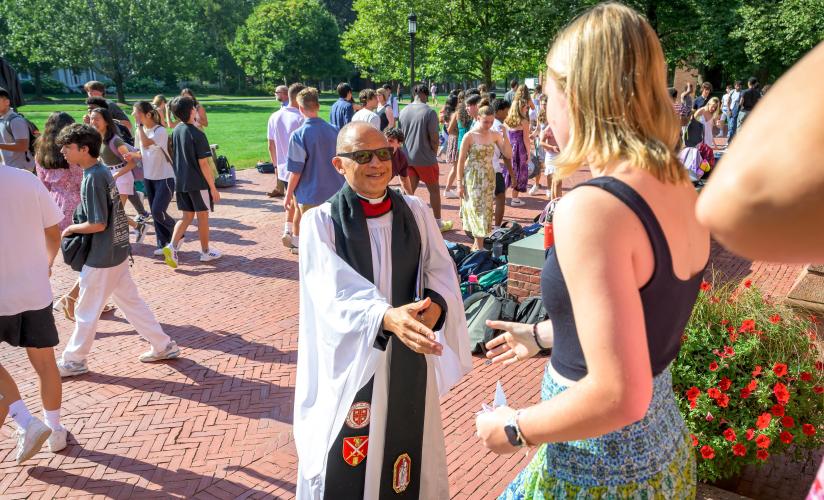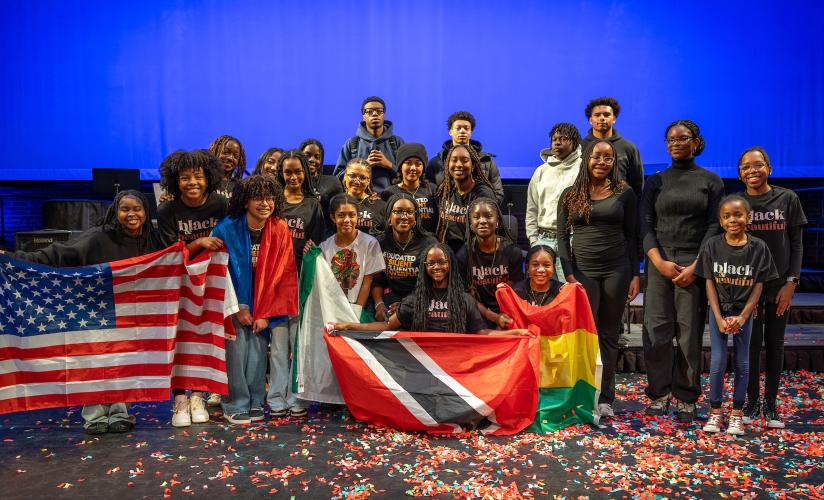

Black excellence in the arts and education are the focus of four full weeks of events.
BY JACQUELINE PRIMO LEMMON
“Oftentimes, Black art is invisible,” says Bethany Dickerson Wynder, director of diversity, equity and inclusion initiatives at St. Paul’s School. It’s a statement short in words, but one with a long history that reaches into every museum, gallery, theater and stage where contributions by Black artists are hard to find — if they’re there at all. In honor of the United Nations International Decade for “People of African Descent” (2015-2024), with its themes of recognition, justice and development, the St. Paul’s School celebration of Black History Month this February focuses on Black excellence in education and the arts, intentionally highlighting Black visual artists, dancers and musicians.
“There has always been a dialogue among Black artists about the purpose and role of the art,” says Rev. Charles Wynder, the School’s dean of Chapel and spiritual life. “It’s not just about the aesthetic; the aesthetic around Black artists is often connected to the context in which the art is being imagined, created and performed.”
Rev. Wynder’s sentiment was exemplified by the month’s first visiting artist, glyneisha johnson, in her Chapel talk on Monday, Jan. 30. “Another Black man was killed by the police yesterday,” johnson told the School community at the start of her talk. “I’m sorry I didn’t give you a trigger warning or a moment to adjust your allyship for this conversation, but another Black man was killed by the police yesterday.”
Black History Month this year comes in the wake of the Jan. 7 beating death of Tyre Nichols by five police officers in Memphis, and the subsequent Jan. 27 release of video footage of the beating; johnson’s point, however, was to offer up the broader context in which she works and to present a preview of the message about the invisibility of art in certain places, the Black interior and everydayness that she shared in class visits and workshops during the course of her weeklong visit. “What does it mean to have courage in a moment of repression?” johnson asked during her Chapel talk. “How do we present ourselves as allies, accomplices, or co-conspirators in the liberation of ourselves in our communities?”
It is in this context that Black artists visiting SPS this month will be speaking and performing, whether their art addresses these events directly or not. “We’re really working intentionally to make sure that Black artists are visible and seen,” says Dickerson Wynder, adding that faculty members from the dance, music and fine arts programs were heavily involved in the month’s programming and in securing visiting artists. The focus on Black excellence in education and the arts also extends to classroom curriculums, making the efforts fully cross-departmental and campuswide.
The month’s leading objective is to promote a greater knowledge of, and respect for, the diverse heritage, cultures and contributions of people of African descent to the development of societies. Rev. Wynder notes that the SPS community of students, faculty and staff includes individuals from Africa, Haiti, Latin America, the Dominican Republic, Ghana and more, and that it’s important that Black SPS community members from other countries are able to “see themselves in the celebration,” in addition to those from the U.S. “It’s a special moment to really speak to contemporary concerns as well as history. The history is informing who we are,” he says.
For Hudson Stovall ’24, a student leader with Onyx — the SPS affinity group for students who identify as Black, African American or of African heritage — Black History Month is about celebrating and acknowledging the rich history of the Black diaspora; he will host an SPS Black Alumni Panel on Feb. 26 as part of the month’s events.
“Onyx makes Black students feel comforted in a space where there are not many of us,” Stovall says. “As an Onyx head, I try to emulate that goal. Through my Black Success & Leadership Panel, I plan to show current SPS students real and in-person examples of Black excellence. I want students to see someone who looks like they exemplify a physical embodiment of their dreams — a right many previous generations weren’t privy to.”
Further programming at SPS this Black History Month includes themed meals in Coit (a Southern cuisine breakfast, West African dinner, Afro-Cuban dinner and West Indian dinner); visiting artists Michaela DePrince, a Sierra-Leonean American dancer with the Boston Ballet, and Sons of Mystro, a violin duo that performs in multiple genres; the SPS Black Alumni Panel; and profiles of Black excellence featured in Chapel and SPS Connected throughout February. Onyx held the primarily student-led Third Annual Student Black History Month Celebration on Sunday, Feb. 12, and the Feb. 21 “In Service to the Greater Good” panel will include alumna Lorene Cary ’74, bestselling author and civic engagement advocate.
“Black History Month is about recognizing the pain and strife, celebrating the accomplishments and efforts, and planning for the betterment of my people,” Stovall says. “The suppression of the Black narrative has run too deep throughout the history of this country. …The purpose of Black History Month is to remind ourselves of the true history … of all our accomplishments, triumphs, and most importantly, our beauty.”



